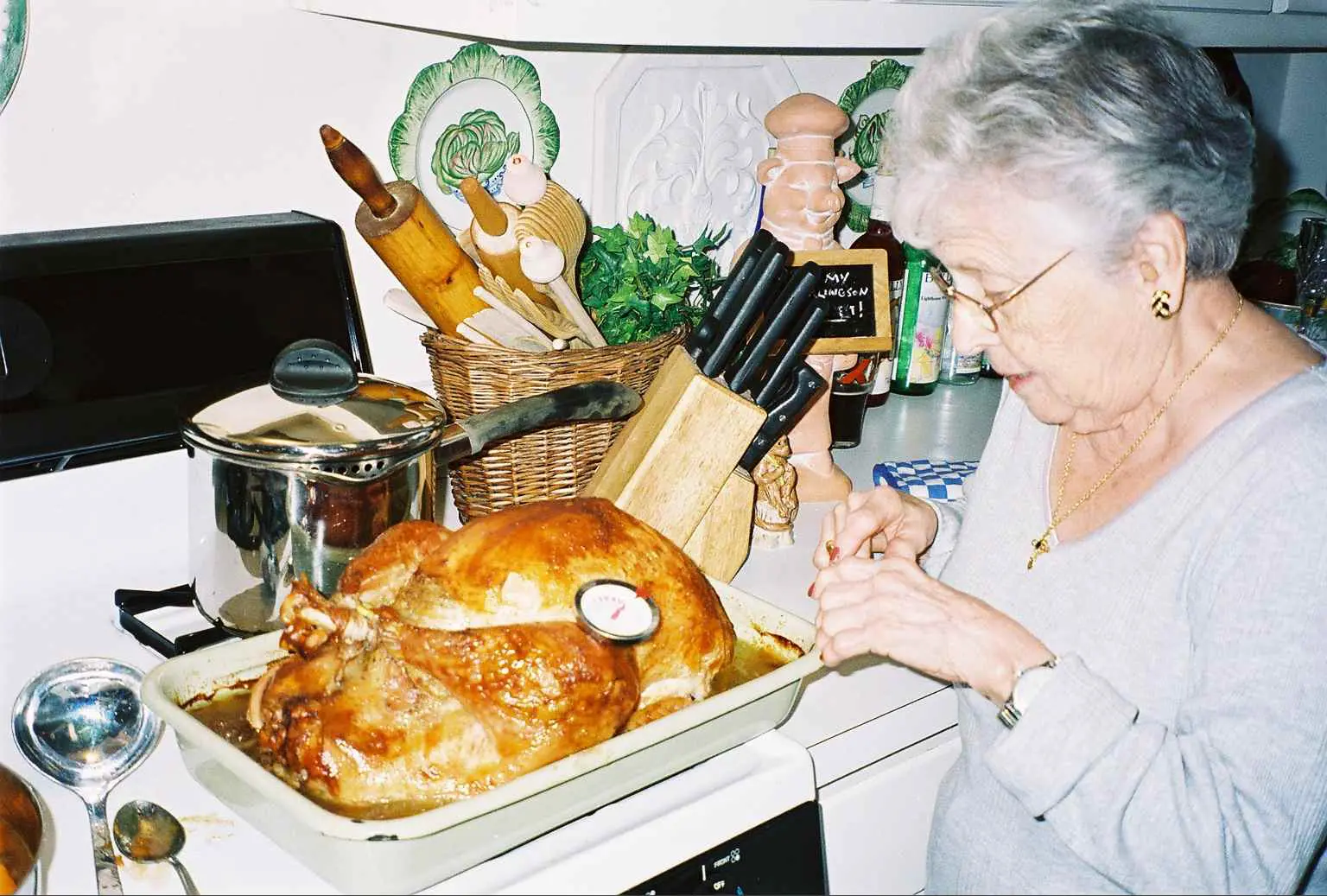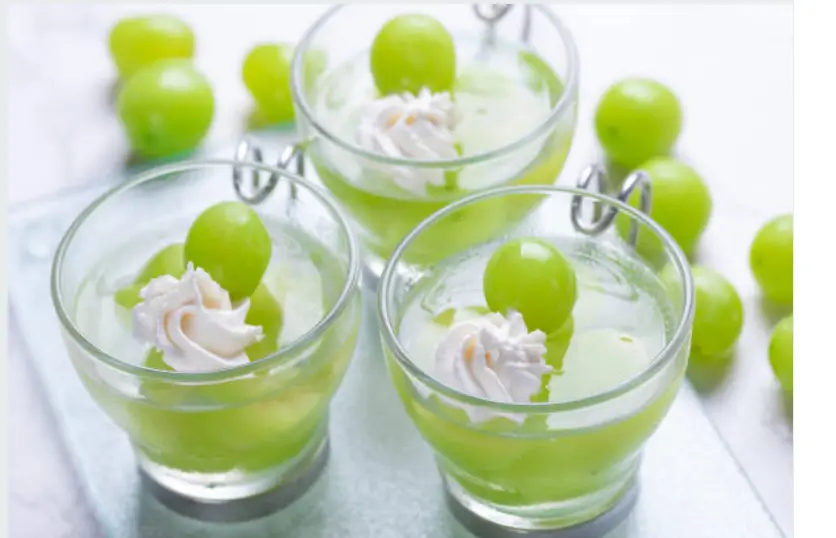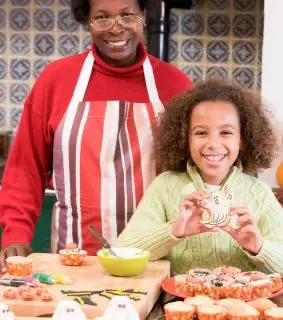What's For Dinner?

from Helene's Kitchen

St. Patrick's Day Favorite Recipes
St. Patrick's Day Irish Delights!
Emerald Salad
Shamrock Rolls
Corned Beef and Cabbage
Lamb Stew
St. Patrick's Day Emerald Salad

Ingredients
1 1 lb. can sliced peaches with syrup
2 3 oz. pkgs. lime gelatin
2 cups boiling water
1 red maraschino cherry
1 cup halved and seeded fresh grapes
or 1 8 oz. can grapes, drained
Directions
Drain peaches, save syrup. Add enough warm water to syrup to make 1 cup. Dissolve gelatin in boiling water. Add cold water and the peach syrup. Chill until jelly-like. Place one cup of gelatin mixture into 6 cup salad mold. Place 12 peach slices on top of the gelatin, forming a sunburst. Place cherry in center. dice remain peaches. Add peaches and grapes to remaining gelatin. Pour into mold. Chill until firm. Unmold onto chilled serving plate.
Shamrock Rolls
Ingredients
Basic bread dough or frozen bread dough, thawed
muffin pan
Directions
Grease muffin pan. Make small balls out of dough. Place three balls in each muffin tin. Brush each with melted butter. Let rise until reach top of muffing tin. Bake at 375 degree for 18 minutes.
St. Patrick's Day Irish Favorite Dish - Corned Beef!
Corned Beef and Cabbage
Ingredients
Corned Beef Brisket
4 potatoes
3 carrots
1 medium cabbage
Directions
Wash brisket under water. Place in pan cover with water bring to a boil Turn heat down. Add peeled potatoes and carrots cut in hunks. Cover and simmer for 30 minutes. About 20 minutes before the corned beef is done, wash cabbage, cut in wedges and add, cook uncovered.
Irish Lamb Stew
Ingredients
2 1/2 lbs. Lamb Stew Meat cut in 1/12/ inch cubes
1 onion pealed and sliced
1 lbs. carrots (optional)
1/4 cup minced parsley
1/2 tsp. ground thyme
pepper to taste
2 cups water
Directions
Place 1/2 of lamb in bottom of dutch oven. Place 1/2 of onions, and carrots on top. Then make another layer with remaining lamb, onion and carrots. Top with parsley, thyme and pepper. Pour water over stew, water should cover. Put lid on dutch oven and place over medium heat. Heat to a boil, then reduce heat and simmer for one hour or until lamb is tender. Check from time to time to make sure water does not all evaporate. Add no more than 1/4 cup water. Stew should be quite thick.
Why Eat Corned Beef on St. Patrick's Day?
Originally "Corned Beef and Cabbage" was a traditional dish served for Easter Sunday dinner in rural Ireland. The beef, which was salted or brined during the winter to preserve it, could then be eaten after the long, meatless Lenten fast.
Since the advent of refrigeration, the trend in Ireland is to eat fresh meats. Today this peasant dish is more popular in the United States than in Ireland. Irish-Americans and lots of other people eat it on St. Patrick's Day, Ireland's principal feast day, as a nostalgic reminder of their Irish heritage.
Corning is a form of curing; it has nothing to do with corn. The name comes from Anglo-Saxon times before refrigeration. In those days, the meat was dry-cured in coarse "corns" of salt. Pellets of salt, some the size of kernels of corn, were rubbed into the beef to keep it from spoiling and to preserve it.
Today brining -- the use of salt water -- has replaced the dry salt cure, but the name "corned beef" is still used, rather than "brined" or "pickled" beef. Commonly used spices that give corned beef its distinctive flavor are peppercorns and bay leaf. Of course, these spices may vary regionally.
Preparation
Corned beef is made from one of several less-tender cuts of beef like the brisket, rump or round. Therefore, it requires long, moist cooking. Keep food safety in mind when preparing the corned beef. It can be cooked on top of the stove or in the oven, microwave or slow cooker (see information below).
"Fork-tender" is a good indication of doneness, but use a meat thermometer to be sure. Cook until the internal temperature has reached at least 160 degrees F.
Corned beef may still be pink in color after cooking. This does not mean it is not done. Nitrite is used in the curing process. This fixes pigment in the meat and affects the color.
Allow the brisket to stand for about ten minutes after removing from the heat. This will make it easier to slice, and it is best sliced diagonally across the grain of the meat.
Cooking Times
The USDA does not recommend one particular cooking method as best. Following are methods from various sources. The cooking times are based on corned beef that is not frozen at the time of cooking. Whichever method you choose, be sure the beef reaches an internal temperature of at least 160 degrees F to ensure it is safely cooked.
- OVEN: Set the oven for 350 degrees F or no lower than 325 degrees F. Place brisket fat-side up. Barely cover the meat with water -- about one inch -- and keep the container covered throughout the cooking time. Allow about one hour per pound.
- STOVE TOP: Place brisket fat-side up in a large pot and cover it with water. Bring the water to a boil; then reduce the heat and simmer, allowing about one hour per pound. Vegetables may be added during the last 20 to 30 minutes of cooking. Cook to desired tenderness.
- SLOW COOKER: If using root vegetables, put them in the bottom of slow cooker. Cut brisket into pieces of like size to ensure thorough cooking. Place brisket on top of vegetables (if using) or in bottom of cooker. Add about 1-1/2 cups of water or enough to cover meat. Cover and cook on high setting for the first hour of cooking. Then cook for 10 to 12 hours on the low setting or 5 to 6 hours on high. Cabbage wedges may be added on top of the brisket during the last three hours of cooking.
- MICROWAVE: Calculate cooking time at 20 to 30 minutes per pound. Place brisket in a large casserole dish and add 1-1/2 cups of water. Cover with lid or vented plastic wrap and microwave on medium-low (30 percent power) for half the estimated time. Turn meat over and rotate dish. Microwave on high for remainder of time or until fork tender. Vegetables may be added during the final 30 minutes of cooking.
About Us-
Contact Us -
Privacy Policy©2023 TheParentVine.com a brand owned by GADL Enterprises, LLC. All rights reserved.
TheParentVine.com earns commissions on products sold.





